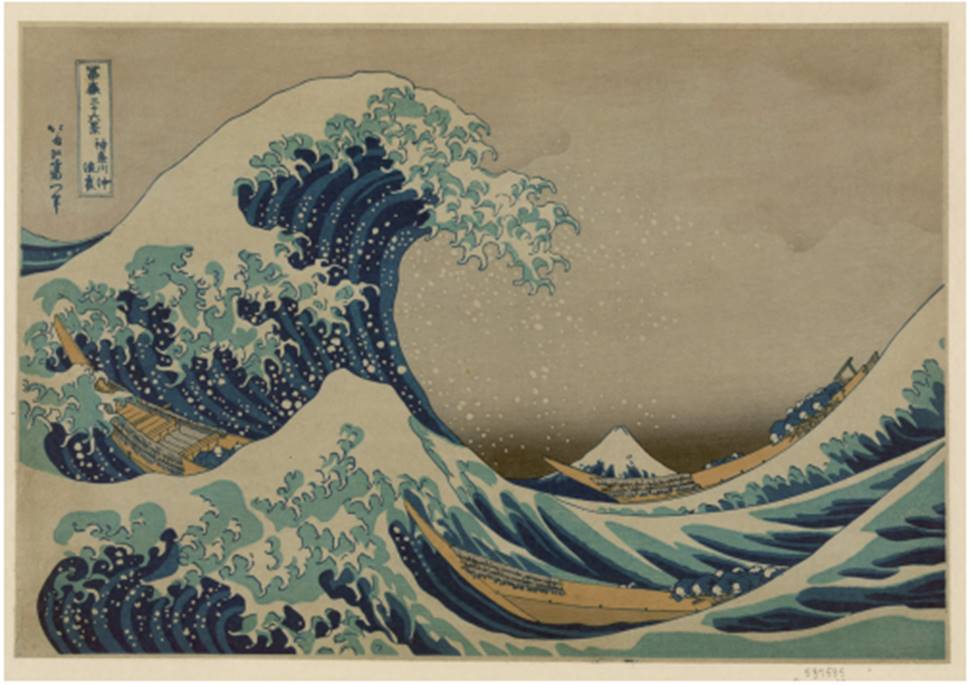Hokusai's Great Wave: Iconic Art Meets the Science of Rogue Waves
The Great Wave Off Kanagawa is a two-dimensional print that has become one of the world’s most famous art pieces representative of Japan. The unique woodblock print was created by the Japanese artist Katsushika Hokusai (1760-1849). It shows an enormous wave about to break on Japanese wooden fishing boats being tossed about in a raging sea. The enormity of the wave is depicted by the presence of a tiny Mount Fuji, which is, in fact, the highest peak in Japan. It has also sparked many conversations about the power of the ocean, leading to intellectual analysis of wave activity specific to the distinction between tsunamis and rogue waves.
Hokusai was born in October or November 1760, though there are no confirmed records. His birth was during the Edo period in Japan. This refers to a period when there were only four divisions of society, of which he belonged to the artisan sect. As a child, he learned woodcarving, woodblock printing, and painting at the Katsukawa School. He often changed his name, which was a trend at the time. Every time he changed his style of art, he changed his name, thus totaling thirty name changes in all. He became a very influential artist and created over 30,000 works of art in his lifetime until he passed away in 1849.
The most famous of his works was The Great Wave Off Kanagawa, created as a woodblock print in 1830, when he was seventy years of age. He used a process unique to Japan called ukiyo-e art, which translates to “picture of the floating world.” Hokusai carved the images onto a series of blocks and painstakingly printed them to create a multilayered image. Japanese water-based inks were used to create color, and a unique European color called Prussian blue was used together with indigo to boost the image. The print comes from a collection he called “Thirty-Six Views of Mount Fuji.” It shows his obsession with the sacred Mount Fuji, which many Japanese shared at that time. The Great Wave became the most popular piece of the collection due to the mastery of imagination combined with artistic technique. The collection was received by a world audience in 1853 when Japan opened its ports and doors to the Western world, thus the world got to see Japanese art for the first time.

Iconic woodblock print The Great Wave off Kanagawa by Katsushika Hokusai, c. 1829-33 (Library of Congress)
Initially, many people interpreted the Great Wave to be a print of a tsunami caused by a powerful event. It caused quite a stir in other nations, as it was also taken to be representative of the dangers of a natural disaster. But as the popularity of the piece grew, having been circulated worldwide outside of Japan, so did the fascination with its meaning. As a piece of art, many saw it for its clever depiction of clawed finger waves showing the restless beauty of the ocean, but some looked beyond an artistic appreciation. In fact, the image drew the attention of scholars who believed the huge wall of water cresting as a blue breaker was not a tsunami. In terms of science and the direct observation of nature and the power of the ocean, they sought to show that the Great Wave was indeed a rogue wave.
Julyan H. E. Cartwright and Hisami Nakamura took the opportunity to study the print and suggested it had a much further impact. They used the known dimensions of the fishing boats shown in the print to determine the size of the wave, which they estimated was about 39 feet tall. Furthermore, Cartwright and Nakamura believed that it represented a rogue wave as opposed to a tsunami based on the height, steepness, water displacement, and localized wave function. In fact, they were able to determine that it was a plunging breaker. This sparked other scientists and physicists to conduct their own theories about the Great Wave, most concluding it was a depiction of a rogue wave.
Whereas the world of science saw parallels to wave phenomena, the art world saw something far different, saying it represented a full visual play. The Great Wave Off Kanagawa holds many things for many people, and as an artistic piece, it is open to interpretation. The striking design and clever perspective create a stir to this day in art galleries across the world. And together with the world of science, they both agree it is definitely a tribute to the extraordinary power of nature and the ocean. Nadia Ali
FURTHER READING:Calza, Gian Carla. 2004. Hokusai. New York City: Phaidon Press.
Guth, Christine, Skye. 2015. Hokusai’s Great Wave: Biography of a Global Icon. Honolulu: University of Hawai‘i Press.
King, James. 2010. Beyond the Great Wave: The Japanese Landscape Print, 1727-1960. Bern: Peter Lang.
The Royal Society of Publishing. 2007. “What Kind of a Wave Is Hokusai’s Great Wave Off Kanagawa?” http://rsnr.royalsocietypublishing.org/content/63/2/119. Accessed October 20, 2017.
Date added: 2025-10-14; views: 129;
